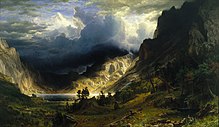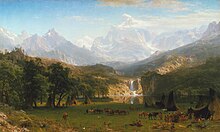Albert Bierstadt
Albert Bierstadt (born January 7, 1830 in Solingen , † February 18, 1902 in New York City ) was an American painter of German origin.
life and work
When Bierstadt was two years old, his parents and two other sons left Germany and settled in New Bedford , Massachusetts in 1833 , which was then an important center of the American whaling industry . Bierstadt's father had found work as a cellar master there . Little is known about his youth. In 1850 Bierstadt, who was self-taught , began a professional career as a drawing teacher . In this early phase he got to know daguerreotypists who aroused his interest in photography . His brother Edward became a professional photographer.
With the intention of receiving formal training from his mother's cousin , the painter Johann Peter Hasenclever , he returned to Germany in 1853. Hasenclever passed away shortly before Bierstadt's arrival in Düsseldorf . The young American stayed with his painter friends, who supported him. From 1853 to 1857 Bierstadt studied at the Düsseldorf Art Academy , including landscape painting with Carl Friedrich Lessing and Andreas Achenbach and other representatives of the Düsseldorf School of Painting . He joined the painter Emanuel Leutze , who was six years his senior , who grew up in the USA like him and was also looking for his European roots. Together with other painter friends - Sanford Robinson Gifford and Worthington Whittredge - he toured Germany, Switzerland and Italy . Bierstadt made numerous sketches here, which he later used in his studio as a template for large-scale oil paintings; the monumental should become his trademark.
He returned to the United States in July 1857, first organizing art exhibitions in his hometown, and then moving to nearby New York City , where he quickly gained recognition. In 1858 he showed some of his large-format works for the first time at the annual exhibition of the National Academy of Design : his painting of Lake Lucerne with the Swiss Alps in the background was very well received - Bierstadt was elected a member ( NA ) of the academy in 1860 .
In the spring and summer of 1859 he took part in an expedition to the West: Colonel Frederick W. Lander had received an order from the US Department of the Interior to scout out a covered wagon route to California . Bierstadt studied primarily areas in Colorado and Wyoming and brought home a variety of sketches, photographs, and Native American artifacts . He moved into a studio in the famous artist house The Tenth Street Studio Building in Manhattan , where he exhibited his new paintings of the American West and soon became famous.
Bierstadt's work is never realistic , but rather romanticized . He often changed details for the sake of effect and loved dramatic lighting effects. Bierstadt stands in the tradition of academic landscape painting, as it was common in Europe. Here, landscapes are not simply “painted”, but composed in an academic manner - certain types of landscapes trigger certain emotions in people, according to the Western painting tradition. Bierstadt also worked in this tradition.

In 1863 he undertook a journey through the Rocky Mountains , the Yosemite Valley , through Oregon to the Columbia River to the coast of the Pacific Northwest America, accompanied by the writer Fitz Hugh Ludlow , whose wife Rosalie Osborne he was to marry that same year ; the writer later published a book about this trip. The couple built a villa called Malkasten , in memory of the Malkasten artists' association in Düsseldorf, near Irvington on the Hudson River .
In 1867, accompanied by his wife, he went to Europe for a two-and-a-half year stay, where he had already achieved great fame. Two of his paintings - The Rocky Mountains, Lander's Peak (1863) and Storm in the Rocky Mountains, Mount Rosalie (1866) were presented to Queen Victoria in London . The opinion of the critics was divided, however. In 1868 his works were exhibited at the Royal Academy of the Arts in Berlin and he was awarded a gold medal for his painting Among the Sierra Nevada Mountains .
Bierstadt kept in touch with painters from the Barbizon School and with English landscape painters. In 1867 he was awarded the Order of the French Legion of Honor , in 1869 the Austrian Order of Saint Stanislaus .
From 1871 to 1873 he lived with his wife in California, once again toured the west and Canada and visited the Bahamas , where his wife, who was sick with consumption , had moved into an apartment because of the mild climate. On all these trips several hundred sketches for later oil paintings were made. Until the 1880s, the extremely productive beer town still traveled through North America and created commissioned works for the American government, among others. Two of his monumental works hang in the Capitol at Washington, DC

After Bierstadt's studio in Irvington-on-Hudson was completely burned out in 1882, he finally moved to New York City. Gradually, however, interest in his works waned: At a time when American society was completely focused on technical progress and industrial development , there was no longer any room for images that conjured up an ideal Garden of Eden and its endangerment: His huge painting “The Last of the Buffalo ”, which he submitted for the Paris World's Fair in 1889 , was rejected by the American selection committee.
The death of his wife in 1883 and other strokes of fate burdened the aging artist, who died lonely and penniless in New York in 1902; as early as 1895 he had to declare his bankruptcy . After his death, Bierstadt was almost completely forgotten until he was rediscovered in the USA in the 1960s as part of the nature and environmental movement . In particular, his small oil sketches, intended as “preparatory work”, were exhibited again and received late recognition. In the homes of many American families there are reproductions of his pictures conjuring up the paradise of the “ Wild West ”.
Today Albert Bierstadt is considered to be one of the most important painters of the so-called Hudson River School , sometimes also called Rocky Mountain School : This was a loose association of American east coast painters who, in their monumental landscapes, portray the untouched American West as the Garden of Eden of the new Transfigured the world . Bierstadt's works hang in the most important museums in the USA and Europe.
In 1898 he was elected to the American Academy of Arts and Letters .
Works (selection)
- Canyon landscape (around 1860), Solingen Art Museum , Solingen-Gräfrath
- The Rocky Mountains, Lander's Peak (1863), Museum of Modern Art , New York City
- Looking Down Yosemite Valley, California (1865), Birmingham Museum of Art , Alabama
- Storm in the Rocky Mountains, Mount Rosalie (210.8 × 361.3 cm) 1866, The Brooklyn Museum , New York City
- The Domes of the Yosemite (1867), St. Johnsbury Athenaeum, Vermont
- Emigrants Crossing the Plains (1867), National Cowboy Hall of Fame, Oklahoma City
- Valley of Kern's River, California (1875), State Hermitage Museum , Saint Petersburg
- The Shore of the Turquoise Sea (1878), private property
- Sunlight Through Storm (1870/80), North Frisian Museum. Nissenhaus Husum
- The Last of the Buffalo (1888), Corcoran Gallery of Art, Washington, DC
Individual evidence
- ^ Nationalacademy.org: Past Academicians "B" / Bierstadt, Albert NA 1860 ( Memento of August 6, 2014 in the Internet Archive )
- ↑ See article Tenth Street Studio Building in the English language Wikipedia
- ^ Members: Albert Bierstadt. American Academy of Arts and Letters, accessed February 16, 2019 .
- ^ Metropolitan Museum
- ↑ brooklynmuseum.org
- ↑ St. Johnsbury Athenaeum
- ^ National Cowboy & Western Heritage Museum
literature
- Matthew Baigell: Albert Bierstadt . New York 1981, ISBN 0-8230-0493-7 .
- Gordon Hendricks: Albert Bierstadt, Painter of the American West . New York 1973, ISBN 0-517-66284-1 .
- Stephan Koja (Ed.): America (sic!). The New World in 19th Century Pictures . Prestel-Verlag, Munich, London, New York 1999, ISBN 3-7913-2051-3 .
- Albert Bierstadt, in: Karsten Müller, Ortrud Westheider (Ed.): New World. The invention of American painting . Hirmer-Verlag, Munich 2007, pp. 192–201.
Web links
- Works by Albert Bierstadt at Zeno.org .
- Paintings by Albert Bierstadt in Chronological Order
- Short bio with photo
- William S. Talbot on the Western Expedition
- Michaela Maier: Albert Bierstadt: Rocky Mountains - Lander's Peak . Heidelberg 1999 (Master's thesis) (PDF file; 580 kB)
- Lance Mayer, Gay Myers: Bierstadt and Other 19th-Century American Painters in Context (JAIC, 1999, Volume 38, Number 1, Article 6, pp. 55–67)
- Art Museum Solingen
- Paola von Wyss-Giacosa : Bierstadt, Albert. In: Sikart (status: 2018), accessed on February 23, 2018.
- Bio Bierstadt in the National Gallery of Art
- YOSEMITE VALLEY by Albert Bierstadt sold at Sotheby's, New York for 2,517,000 USD (Hammer Price with Buyer's Premium) on May 21, 2014
| personal data | |
|---|---|
| SURNAME | Bierstadt, Albert |
| BRIEF DESCRIPTION | American painter |
| DATE OF BIRTH | January 7, 1830 |
| PLACE OF BIRTH | Solingen |
| DATE OF DEATH | February 18, 1902 |
| Place of death | New York City |


